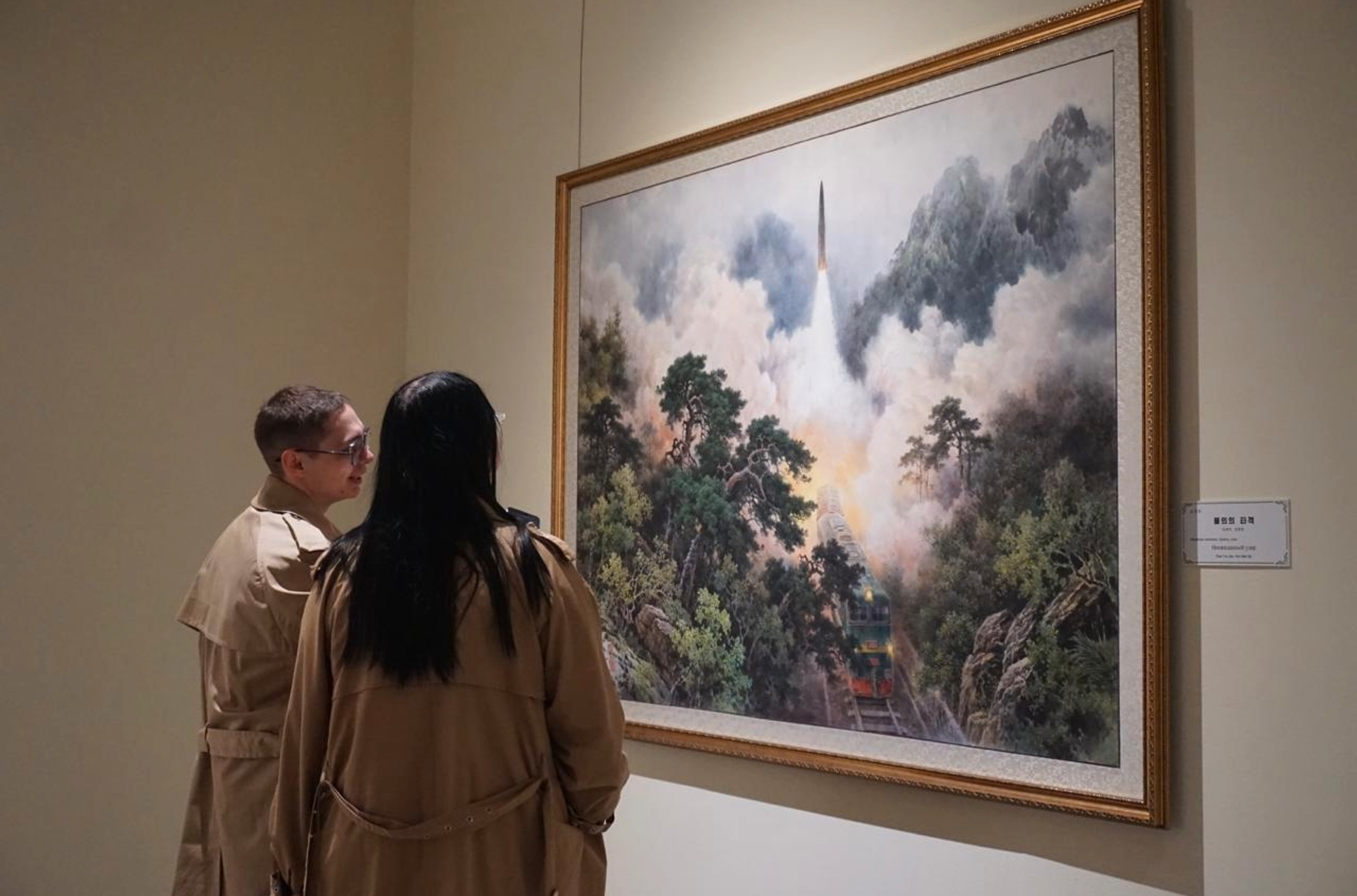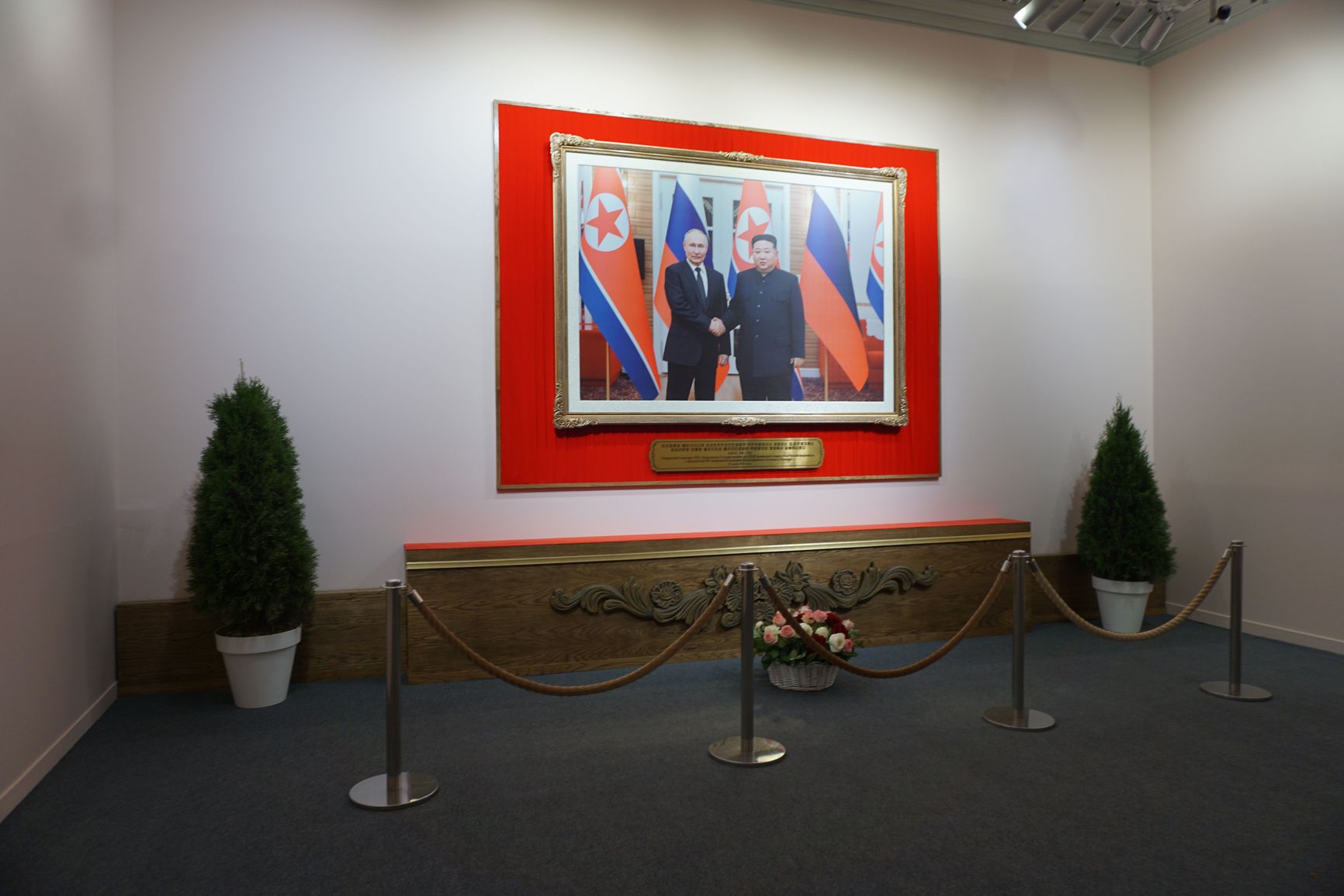An exhibition of North Korean art titled “The Democratic People’s Republic of Korea: The Country of a Great People” has taken place at Moscow’s All-Russian Museum of Decorative Art. The Insider’s correspondent visited the show and reviewed the comments that visitors left in guestbooks. The reactions were mostly positive, less because of the art itself and more thanks to North Korea’s support of Russian troops in countering the Ukrainian incursion into Russia’s Kursk Region.

“Art Exhibition of the DPRK: The Country of a Great People.” Photo: The Insider
“The Country of a Great People” opened on Sept. 8 and ran for just over a month. A total of 123 works were displayed — mostly paintings and pieces of applied art. But perhaps the most striking exhibits were the guestbooks, which contained thousands of messages. Visitors expressed “delight, admiration, and reverence for the works on display,” calling them “magnificent, impressive, and deeply inspiring” while also thanking North Koreans “for their help and friendship” and “for their assistance in the Kursk Region.”
One of the earliest entries read:
“Thank you to our brothers for their help in a difficult time! A wonderful exhibition for understanding the soul of the Korean people. Preserve your achievements and your identity. Wagner fighter Tyaga.”
“The Country of a Great People” opened on Sept. 8 and ran for just over a month.
Photo: The Insider
One of the exhibition's guestbooks.
Photo: The Insider
The top entry is signed "Wagner fighter Tyaga."
Photo: The Insider
This message, signed "Natalia" and dated Oct. 10, rounds off with "Glory to North Korea!!!"
Photo: The Insider
“So frightening it’s not even funny”
Two guestbooks were set out: a general one at the entrance and another dedicated specifically to the North Korean exhibition at the end of the hall. One of the attendants said that one copy would remain in the museum, while the other would be translated and sent to Kim Jong Un — or, at least, the pages that pass censorship would. North Korean representatives overseeing the exhibition reportedly informed the attendants of this plan.
Amid the thousands of enthusiastic notes, only a few skeptical comments could be found:
“So frightening it’s not even funny.”
“Down with totalitarianism!!! We stand for freedom of morals and speech!!! We support free art!!!” (Another visitor added below: “You’re idiots,” and a third: “Seconded.”)
“You should hand out valerian [tablets] or at least vodka to visitors. But thanks for letting us see the official art of the country. A fascinating spectacle with an uncanny-valley effect.”
The above remarks are unlikely to reach Comrade Kim Jong Un.
Several North Korean representatives observed the visitors as they wrote, with one occasionally peering over their shoulders while a translator whispered the messages. When someone noticed the supervision, the North Korean representative would tell them through the translator: “Oh, you wrote such kind words for us! We’re so touched, thank you!”
Most comments were indeed positive:
“The paintings depicting DPRK soldiers participating in the liberation of the Kursk Region moved me deeply. A deep bow to the Korean servicemen who fulfilled their duty in freeing the Region and gave their lives in the war against the neo-Nazis, the Ukrainian Banderites. Glory to the DPRK, eternal friendship with Russia!”
“Thank you, DPRK, for your help and friendship!!! Delight, admiration, reverence for the works presented!!! Many visitors would like the exhibition extended. Glory to North Korea!!! Natalia.”
“Dear North Korean comrades, our brothers-in-arms! Thank you for this wonderful exhibition and the outstanding works of DPRK artists. Prosperity and success to the great people and the party! With fraternal greetings, V. A. Aronin.”
“Thank you for the wonderful exhibition of Korean art!!! It amazes, inspires, and fills the soul with the brightest feelings. Special thanks to the Korean people and the country’s leader for their invaluable help on the front lines of the ‘special military operation.’”
“Considering the Kursk Region their homeland”
Paintings depicting North Korean soldiers fighting in Russia’s Kursk Region were placed at the entrance corridor leading to the main halls.
“A wonderful exhibition! …Especially moving were the paintings with the fighters who helped in the Kursk Region, [we extend] our gratitude to them! Thank you for the exposition; it’s truly a marvelous land!”
“A feeling of pride and joy for our people. Memory and triumph of national dignity. The paintings about DPRK soldiers’ participation in liberating the Kursk Region moved us to the core. Gratitude and remembrance to the brotherly people for their help. The Artamonov family.”
“Special thanks for all the paintings about the participation of Korean soldiers in the special military operation (great gratitude for their courage and help)! We still have to creatively process the experience of the operation, thank you for this poignant example! Expect us to visit! O. A. Nazarova.”
Western reports about North Korean troops’ presence in Russia started appearing in October 2024. However, Russia’s Ministry of Defense acknowledged the participation of North Korean troops in combat in the Kursk Region only in April 2025. Perhaps for that reason, only one painting in the series directly mentions the campaign. Aptly, it is titled “For the Liberation of the Kursk Region.” Another, “In One Trench,” shows soldiers holding North Korean and Russian flags. Other works hanging in the same corridor had a more abstract connection to the ongoing invasion of Ukraine, with titles such as “Echo of Victory in War,” “Giving a Precious Life,” and “Sons of the Motherland.”
“For the Liberation of the Kursk Region”
Photo: The Insider
“In One Trench”
Photo: The Insider
“Giving a Precious Life”
Photo: The Insider
To understand what these “sons of the motherland” were fighting and dying for, visitors could scan QR codes accompanying most paintings. Each led to a short description stored as a separate document on the cloud storage platform Yandex Disk. One example:
“Giving a Precious Life”: “The painting shows the heroic feat of a Korean soldier participating in the special military operation in the Kursk region. He fulfilled his patriotic duty in accordance with the order of Supreme Commander Kim Jong Un, considering the Kursk region a homeland that must be liberated from invaders at any cost.”
“Like the pictures from our youth in the Soviet Union”
Most of the remaining paintings glorified the strength of the DPRK army or depicted the happy, peaceful life of North Korean citizens, whether in modern cities or well-kept villages.
"Our Strength — the 'Padasuri-6' Missile"
Photo: The Insider
"A Sudden Strike"
Photo: The Insider
"Roar of the Iron Horse"
Photo: The Insider
Notably, the paintings’ labels did not list creation dates, suggesting they may have been produced specifically for this exhibition. Museum attendants confirmed that the works were “very recent” and had been handpicked for display in Moscow.
"A New Street for the People"
Photo: The Insider
"Luxurious Homes for the People"
Photo: The Insider
"Patriotic Spirit"
Photo: The Insider
"Kimchi-Making Season"
Photo: The Insider
"Happy Homeland"
Photo: The Insider
These paintings also drew numerous positive comments. Two visitors said the works reminded them of their Soviet childhood:
“The exhibition is amazing! Bright, joyful faces, smiles, inspiration in their eyes! Just like the pictures from our youth in the Soviet Union. It’s like stepping back into [one’s] childhood. Thank you for the positivity we all miss so much! Lyudmila, Elena.”
Another, surprisingly, remarked that she had seen less of North Korea while visiting Pyongyang than she saw at the exhibition — and meant it as praise:
“When we were in Pyongyang, they didn’t show us anything like what’s depicted here. In Moscow, at this exhibition, you can see much more than in North Korea itself! And that’s wonderful, absolutely great!”
Others praised authoritarian traditional values:
“I admire the hardworking enthusiasm of DPRK citizens, their happy faces, faith in their country, and defense of their interests against imperialist attacks by unfriendly states. These people work hard, believe in their future, and respect their leaders.”

Photo: The Insider
One exhibit was off-limits for photography — a large photograph of Kim Jong Un and Vladimir Putin taken during the Russian dictator’s visit to North Korea last year. According to one museum attendant, the North Korean side included the restriction in the exhibition agreement. A DPRK representative explained that the image was an official photograph, so only members of official delegations were permitted to be photographed in front of it. Nevertheless, many visitors quietly took pictures of the restricted exhibit anyway.